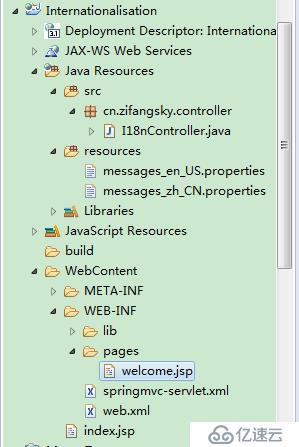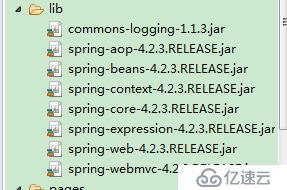您好,登录后才能下订单哦!
所谓国际化就是支持多种语言,web应用在不同的浏览环境中可以显示出不同的语言,比如说汉语、英语等。下面我将以具体的实例来举例说明:
(1)新建动态Java web项目,并导入几个SpringMVC必需的几个jar包,项目结构图和所需jar包如下:


(2)配置web.xml:
<web-app xmlns="http://xmlns.jcp.org/xml/ns/javaee" xmlns:xsi="http://www.w3.org/2001/XMLSchema-instance" xsi:schemaLocation="http://xmlns.jcp.org/xml/ns/javaee http://xmlns.jcp.org/xml/ns/javaee/web-app_3_1.xsd" version="3.1"> <servlet> <servlet-name>springmvc</servlet-name> <servlet-class>org.springframework.web.servlet.DispatcherServlet</servlet-class> <load-on-startup>1</load-on-startup> </servlet> <servlet-mapping> <servlet-name>springmvc</servlet-name> <url-pattern>*.html</url-pattern> </servlet-mapping> <filter> <filter-name>characterEncodingFilter</filter-name> <filter-class>org.springframework.web.filter.CharacterEncodingFilter</filter-class> <init-param> <param-name>encoding</param-name> <param-value>UTF-8</param-value> </init-param> </filter> <filter-mapping> <filter-name>characterEncodingFilter</filter-name> <url-pattern>/*</url-pattern> </filter-mapping> </web-app>
常规配置,没有什么特殊的地方,不多解释
(3)SpringMVC的配置文件springmvc-servlet.xml:
<?xml version="1.0" encoding="UTF-8"?> <beans xmlns="http://www.springframework.org/schema/beans" xmlns:xsi="http://www.w3.org/2001/XMLSchema-instance" xmlns:context="http://www.springframework.org/schema/context" xmlns:mvc="http://www.springframework.org/schema/mvc" xsi:schemaLocation="http://www.springframework.org/schema/beans http://www.springframework.org/schema/beans/spring-beans-4.0.xsd http://www.springframework.org/schema/context http://www.springframework.org/schema/context/spring-context-4.0.xsd http://www.springframework.org/schema/mvc http://www.springframework.org/schema/mvc/spring-mvc-4.0.xsd"> <context:component-scan base-package="cn.zifangsky.* *.controller" /> <context:annotation-config /> <!-- 激活Bean中定义的注解 --> <mvc:annotation-driven /> <!-- 视图相关配置 --> <bean class="org.springframework.web.servlet.view.InternalResourceViewResolver"> <property name="prefix" value="/WEB-INF/pages/" /> <!-- 视图前缀 --> <property name="suffix" value=".jsp" /> <!-- 视图后缀 --> </bean> <!-- 存储区域设置信息 --> <bean id="localeResolver" class="org.springframework.web.servlet.i18n.SessionLocaleResolver" /> <!-- 国际化资源文件 --> <bean id="messageSource" class="org.springframework.context.support.ReloadableResourceBundleMessageSource"> <property name="basename" value="classpath:messages" /> </bean> <mvc:interceptors> <bean id="localeChangeInterceptor" class="org.springframework.web.servlet.i18n.LocaleChangeInterceptor"> <property name="paramName" value="lang" /> </bean> </mvc:interceptors> </beans>
在上面的配置中,SessionLocaleResolver类通过一个预定义会话名将区域化信息存储在会话中。紧接着的“messageSource”配置的是国际化资源文件的路径,”classpath:messages”指的是classpath路径下的messages_zh_CN.properties文件和messages_en_US.properties文件。在这个配置文件的最后配置的是一个拦截器,该拦截器通过名为”lang”的参数来拦截HTTP请求,使其重新设置页面的区域化信息
(4)两个国际化资源文件:
i)messages_zh_CN.properties文件:
language.cn = \u4e2d\u6587 language.en = \u82f1\u6587 internationalisation = \u56fd\u9645\u5316 welcome = \u6b22\u8fce\u8bbf\u95ee\u201c\u007a\u0069\u0066\u0061\u006e\u0067\u0073\u006b\u0079\u7684\u4e2a\u4eba\u535a\u5ba2\u201d\uff0c\u0055\u0052\u004c\uff1a\u0068\u0074\u0074\u0070\u003a\u002f\u002f\u0077\u0077\u0077\u002e\u007a\u0069\u0066\u0061\u006e\u0067\u0073\u006b\u0079\u002e\u0063\u006e
ii)messages_en_US.properties文件:
language.cn = Chinese language.en = English internationalisation = \u0020Internationalisation welcome = Welcome to visit "zifangsky's personal blog",URL\uff1ahttp://www.zifangsky.cn
注:上面一些看起来“乱码”的地方实际上是经过Unicode编码的
(5)后台处理请求的controller:
package cn.zifangsky.controller;
import org.springframework.stereotype.Controller;
import org.springframework.web.bind.annotation.RequestMapping;
import org.springframework.web.servlet.ModelAndView;
@Controller
public class I18nController {
@RequestMapping(value = "/hello")
public ModelAndView welcome() {
ModelAndView modelAndView = new ModelAndView("welcome");
return modelAndView;
}
}这个controller很简单,就是转到一个视图页面welcome.jsp
(6)首页的index.jsp:
<% response.sendRedirect("hello.html"); %>意思很简单,就是项目启动之后就请求htllo.html,也就是让controller中的welcome方法处理这个请求
(7)welcome.jsp:
<%@ page language="java" contentType="text/html; charset=UTF-8"
pageEncoding="UTF-8"%>
<%@taglib prefix="mvc" uri="http://www.springframework.org/tags/form" %>
<%@taglib prefix="spring" uri="http://www.springframework.org/tags" %>
<html>
<head>
<title>SpringMVC<spring:message code="internationalisation" /></title>
</head>
<body>
Language: <a href="?lang=zh_CN"><spring:message code="language.cn" /></a> - <a href="?lang=en_US"><spring:message code="language.en" /></a>
<h3>
<spring:message code="welcome" />
</h3>
Locale: ${pageContext.response.locale }
</body>
</html>可以看出,在需要使用国际化处理的地方都使用了Spring的message标签,code属性对应资源文件中的“键”名称
(8)最后的显示效果如下:
i)中文:

ii)英文:

免责声明:本站发布的内容(图片、视频和文字)以原创、转载和分享为主,文章观点不代表本网站立场,如果涉及侵权请联系站长邮箱:is@yisu.com进行举报,并提供相关证据,一经查实,将立刻删除涉嫌侵权内容。